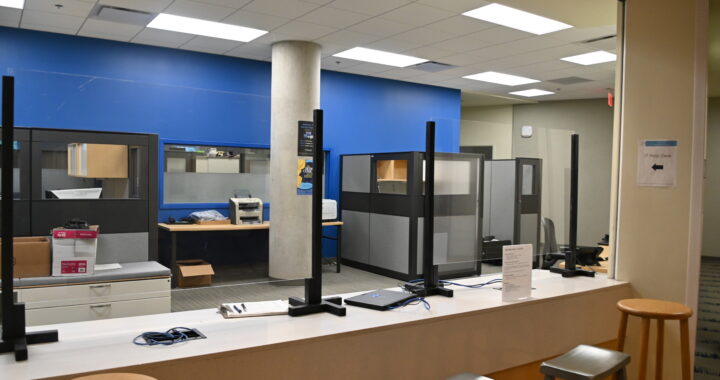UMW science department employs new social distancing measures
3 min read
The UMW science departments have created new guidelines for in-person lab classes with social distancing and disinfecting shared materials. | Edgar Cahoon, chemistryworld.com
by MARY FOSTER
Senior Writer
UMW science faculty have made significant accommodations within their classrooms to comply with COVID-19 restrictions.
Because science classes often involve lab partners and complicated experiments, proper social distancing can be difficult to attain.
“The lab rooms have been measured out into eight foot square boxes and taped out,” said Dr. Lynn Lewis, chair of the biology department.
The other science departments will be following the same format for their in-person classes and are taking precautions seriously.
“Any student not maintaining social distancing will be asked to leave Jepson immediately,” said Dr. Jodie Hayob, the chair of the Earth and environmental science department.
Many lab classes will be splitting students into groups that take turns using lab space and equipment.
“Elementary Astronomy lab will be held with students in three separate rooms,” said Dr. Janet Asper, chair of the chemistry and physics departments.
The physics department decided to move all of their courses online while allowing students to access materials necessary in the Jepson Science Center with social distancing and thorough cleaning.
The biology department will also split their classes into groups.
“Our usual number of 24 students in a lab room is too many. Half that number will fit, so the plan is to have half the students come in one week and half attend the following week to do the same lab,” said Lewis. “As with the rest of campus, students must wear masks at all times. Science students will wear gloves, so they don’t contaminate equipment or specimens, and all countertops will be cleaned before and after labs.”
The EESC department’s solution is more complicated.
“In EESC there is a mix of approaches,” said Hayob. For example, EESC 111 will split classes into 45-minute periods with half of the class attending each period.
The chemistry department will be disinfecting glass equipment in a dishwasher between uses, according to Asper. Chemistry students will be required to use hand sanitizer and will be given a disposable mask for every lab. Anti-fogging spray will also be used on goggles to prevent them from fogging up, and frequently touched surfaces will be disinfected.
Because there are few research students in the science departments, the department chairs are optimistic that remaining socially distant will be easier in the research spaces.
“Most students who are doing independent research are doing so in spaces that aren’t heavily populated to start with,” said Lewis. “Our hope is that research students will be able to complete their projects with a minimum of disruption, though they may have to schedule times to be in particular spaces or use specific equipment.”
The EESC department’s situation is similar.
“We have nine students total in [EESC] working on research projects; this is a combo of field work and lab work. Most faculty are only allowing one student in the research lab at a time, and they are spacing them out every few hours,” said Hayob.
Department chairs also prepared for students who are quarantined.
“The lab will not be hands-on. However, many of our labs emphasize data analysis, which can be done virtually. Many professors are recording labs or planning to Zoom the lab procedures so students can at least watch the experiment being performed. Some labs will also offer more virtual simulations to replace the hand-on equivalent that would have been conducted in person,” said Lewis. Hayob plans to do this as well.
No changes will be made in departmental and course requirements to accommodate the new online nature of the course.
“We are aware that changes may need to be made going forward if, for some reason, a goal cannot be met,” said Lewis.
To generate ideas about how to teach during COVID-19, the chemistry department collaborated virtually with other chemistry professors.
“Several of our faculty are members of a 4,000 person facebook group of chemistry faculty… discussing and developing effective and engaging remote lab experiences,” said Asper.
The biology department researched the best ways to teach through a pandemic.
“We will have to figure out how to give the students the best hands-on experience we can, even without hands-on labs,” said Lewis. “Faculty have spent the summer researching how to do this. It will definitely be different, and it’s not what the faculty would prefer to do, but it may be necessary for the safety of faculty, staff and students. We will adapt and hope the students will too!”


